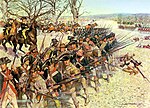Hoskins House Historic District

Hoskins House Historic District, also known as Tannenbaum Park, is a historic log cabin and national historic district located at Greensboro, Guilford County, North Carolina. The Hoskins House is a late-18th or early-19th century chestnut log dwelling house measuring 24 feet by 18 feet. It has an interior enclosed stair and exterior stone chimney. The house was restored in 1986–1987. Also on the property is the contributing Coble Barn (c 1830). It is a large double-pen log barn of hewn V-notched logs under a long wood-shingled gable roof. The barn was moved to and restored at its current location in 1987. The Hoskins House site was the focal point of the British attack during the Battle of Guilford Court House on March 15, 1781. The Hoskins property survives today as an important satellite to the Guilford Courthouse National Military Park.It was listed on the National Register of Historic Places in 1988.
Excerpt from the Wikipedia article Hoskins House Historic District (License: CC BY-SA 3.0, Authors, Images).Hoskins House Historic District
Greensboro Urban Loop, Greensboro
Geographical coordinates (GPS) Address Nearby Places Show on map
Geographical coordinates (GPS)
| Latitude | Longitude |
|---|---|
| N 36.138611111111 ° | E -79.852777777778 ° |
Address
Greensboro Urban Loop
Greensboro Urban Loop
27410 Greensboro
North Carolina, United States
Open on Google Maps



